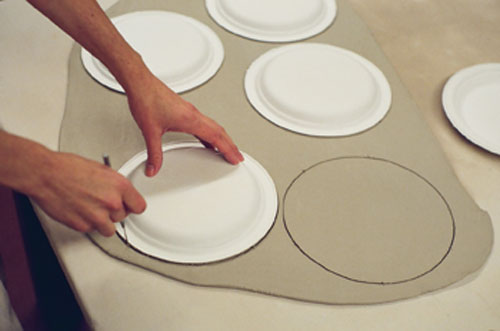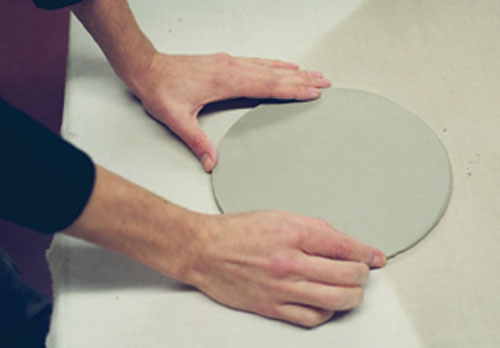Plate Decorating Ideas For Desserts
 We get a lot of inquiries at Ceramic Arts Network from teachers looking for grade-school assignments that can work with a variety of ages. In this post, I have presented an example in which Amanda Wilton-Green explains a cool, simple slab building project that could really be adapted for any grade from kindergarten through high school. What's more, you don't have to have a lot of expensive materials to do it—a huge bonus with a tight budget! - Jennifer Poellot Harnetty, editor.
We get a lot of inquiries at Ceramic Arts Network from teachers looking for grade-school assignments that can work with a variety of ages. In this post, I have presented an example in which Amanda Wilton-Green explains a cool, simple slab building project that could really be adapted for any grade from kindergarten through high school. What's more, you don't have to have a lot of expensive materials to do it—a huge bonus with a tight budget! - Jennifer Poellot Harnetty, editor.
Making a set of ceramic plates (or casserole dish) can be fun for the beginner, but is also easily adapted for the more-experienced student. This project presents a direct and fresh slab-forming approach resulting in plates that become great canvases for surface decoration. Materials are simple, inexpensive and readily available.
After only a few hours of work, you can learn how to roll out a good, even slab, and can experience different stages of plastic clay and what the clay is capable of at each stage. You become familiar with simple slump molds and start to consider the form and function of your work. Most importantly, you learn how to handle clay in a direct and intentional way.
These plates become a wonderful surface for finishing, embellishing and glazing. I have expanded this project to include experiments with paper stencils and slip decoration, but that's just the beginning. Try underglaze design work and glazing methods with this project as well. When the project is completed, you'll have a set of plates to use in your home or to give as gifts.
Equipment and Tools
- Large rolling pin
- Cut-off wire
- Sponge
- 25 lbs of clay with sand or grog to reduce warping
- Fettling knife or needle tool
- Chinet® paper plates.
Note: Chinet® plates do not have a plastic coating and absorb moisture from the clay. Avoid coated and plastic plates.
Getting Started


Roll out a slab to a desired thickness of ¼ to ½ inch. When rolling out a slab, start by throwing it across the table in different directions until it is somewhere close to 3 inches thick. Use a slab roller or a rolling pin to continue rolling the slab to the desired thickness, taking care not to roll over the edges. Roll two or three times on one side. If you're working on canvas, you'll notice that the clay stops stretching after the first few times because the clay holds onto the texture of the canvas. Carefully lift the slab creating as much surface area with your hand as possible, and leave the slab to stiffen to a soft leather-hard stage. The clay needs to be able to bend without cracking, but you don't want fingerprints to show as you manipulate your clay.
Choose the size of your plate. Chinet® brand has dinner, salad and dessert-sized plates as well as an oval platter. Place the plate upside down to use as a template for cutting the slab (figure 1). As you cut, keep your needle tool or fettling knife perpendicular to your work surface to create a square rim.
Remove excess clay and smooth out the rims. Slide your finger across the edge of the rim with firm and consistent pressure (figure 2). The sharp corner of the rim softens without flattening the edge. A damp sponge, chamois or a small piece of a produce bag also works. Stamp or sign the underside.
Forming Plates


Flip the clay slab, smooth the top edge then place it into the paper plate, lining up the edges (figure 3). Experiment with pressing the clay into the paper plate with your hands or sandwiching your clay between two plates (figure 4). The clay will have a different character depending on your chosen method.
Allow the plates to dry to a firm leather-hard stage in the bottom paper plate. Remove the clay from the mold to check to see if the plates stack nicely and sit on a flat surface without rocking. Take a moment to look closely at the rim of each plate to do any final shaping they might need.
Decorating Plates


These plates are adaptable to all sorts of decorative techniques at the leather-hard, greenware and bisque stages. The flat surface lends itself to painterly and expressive underglaze or glaze work. These slab plates are simple enough for very young students and satisfying for the adult student.
Slip decoration gives dimension to the plates and students draw on their own creative design ideas for the work. Textured dessert plates with slip inlay use found and inexpensive materials to create a design and a slip in contrasting color to further highlight the design. Paper stencils used with decorative slip can make bold, graphic borders or motifs for your set of plates (figure 5). With a little experimentation and practice, you'll come up with wonderful results.
Making Sets
When you handbuild a set of plates, every artist approaches each plate with a slightly different perspective. The experience of making the first plate, bowl, mug or tile influences the next, as do things as simple as body position and energy levels. We're thoughtful and inconsistent creatures and we can use these characteristics to great benefit when done so with intention.
A set of plates can be tied together with a theme, color, position of image, size or concept. Because we're used to seeing sets coming from a factory, the default definition in our minds can be limited to identical objects.
**First published in 2010
Plate Decorating Ideas For Desserts
Source: https://ceramicartsnetwork.org/daily/pottery-making-techniques/handbuilding-techniques/great-idea-for-teachers-a-simple-lesson-plan-for-slab-built-plates-with-textured-and-stenciled-decoration/
Posted by: pagelfarge1999.blogspot.com

0 Response to "Plate Decorating Ideas For Desserts"
Post a Comment